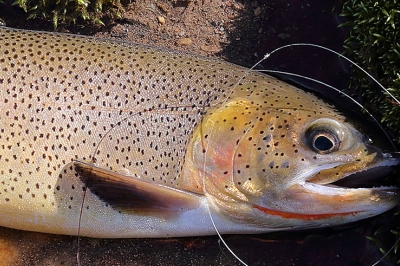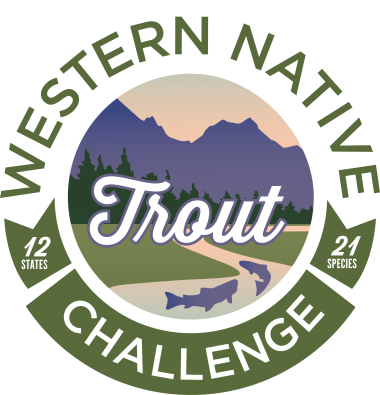
Take the Trout Challenge and help native trout
Take the Western Native Trout Challenge and you’ll learn about native trout and where to find them, earn bragging rights and rewards, and help the Western Native Trout Initiative (WNTI) conserve 21 native trout and char species in 12 states.

It can be said that the lure of the West is native trout. They are the embodiment of the Western character— its eternal struggle and triumph of adaptation to a life of water in a dry land. The wild rivers, the alpine lakes, and the trickling arroyos — the fiber of Western geography — are the habitat for the redband, the cutthroat, and the Gila. The landscape and lore of the West is that of the trout.
The Western Native Trout Challenge
The Challenge is a new lifetime goal opportunity (aka a bucket list item) that you navigate at your own pace. It encourages anglers to help celebrate the West’s trout legacy by inviting them to catch 18 of the native trout and char species throughout 12 states (at the master angler level).
Participants can soak in the beauty of the land and share the thrill of the catch with family and friends in a series of journeys. Use the maps and species information offered by WNTI to individually craft each trip!
Twelve partnering state fish and wildlife agencies in the Pacific Northwest and Mountain states are working with WNTI, along with the USDA Forest Service, Bureau of Land Management and Trout Unlimited, to launch and support the challenge.
The purpose of the challenge is to help anglers understand what is being done to protect, restore and recover trout populations, and to grow the trout fishing community.
How it works
Adults 18 and older pay a one-time fee of $25 and get maps, information, rewards, beautiful scenery and fishing adventures all while learning about different trout species, the best locations and conservation. Kids 17 and under play for free. Of the $25 registration fee, $23 will go back on the ground to help conserve these trout species.
There are three levels to the Western Native Trout Challenge:
- Expert Caster: Six trout species across four states. No duplicate species across states. Anglers pick which species they catch in which states. Receive an artist-rendered certificate and a ball cap.
- Advanced Caster: 12 trout species across eight states. No duplicate species across states. Anglers pick which species they catch in which states. Receive an artist-rendered certificate and a gold medallion.
- Master Caster: 18 trout species across 12 states. No duplicate species across states. Anglers pick which species they catch in which states. Receive an artist-rendered certificate and a platinum medallion.
Oregon trout species
Oregon has five trout species in the challenge: redband trout, bull trout, westslope cutthroat trout, coastal cutthroat trout and Lahontan cutthroat trout. The waterbodies where they spawn and thrive are in nine different zones throughout the state. According to the rules, if you catch three species in Oregon, you’ll need to catch one species in each of three other states to receive the Expert Caster level certification and rewards. Catch more species in more states to achieve the Advanced and Master caster levels.
Register and learn more
All the information you need to register and plan your trout road trips is at WesternNativeTroutChallenge.org.
You also can follow the action at:
- Twitter:@WNativeTrout
- Instagram: @WesternNativeTrout
- FB: /westernnativetrout
More about WNTI
The Western Native Trout Initiative (WNTI) is a program of the Western Association of Fish and Wildlife Agencies and a nationally recognized partnership under the National Fish Habitat Partnership program that works cooperatively across 12 Western states to conserve (protect, restore, and recover) 21 native trout and char species across their historic range. Since its inception in 2006, WNTI has directed more than $29 million in federal, public and private funds to serve 139 priority native trout conservation projects. WNTI and partners have removed 87 barriers to fish passage, reconnected or improved 1,130 miles of native trout habitat, and put in place 30 protective fish barriers to conserve important native trout populations.


